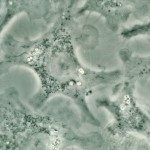Lien vers Pubmed [PMID] – 16021602
Eur J Immunol 2005 Aug; 35(8): 2459-70
Muropeptides are degradation products of bacterial peptidoglycan (PG) sensed by nucleotide-binding oligomerization domain 1 (NOD1) and NOD2, members of a recently discovered family of pattern recognition molecules (PRM). One of these muropeptides, muramyl dipeptide (MDP) mediates cell signaling by NOD2, exerts adjuvant activity and synergizes with lipopolysaccharide (LPS) to induce pro-inflammatory responses in vitro and in vivo. In contrast, few and contradictory results exist about the stimulatory capacity of NOD1 agonists. Thus, the ability of NOD1 (MurNAc-L-Ala–D-Glu-meso-diaminopimelic acid, MtriDAP) and NOD2 (MurNAc-L-Ala-D-isoGln, MDP; MurNAc-L-Ala–D-Glu-L-Lys, MtriLYS) agonists to activate primary human myeloid cells was examined. We show that both CD14+ monocytes and CD1a+ immature dendritic cells (DC) express NOD1 and NOD2 mRNA. Stimulation of primary human monocytes and DC with highly purified muropeptides (MtriDAP, MDP and MtriLYS) induces release of pro-inflammatory cytokines. We reveal here that NOD1 as well as NOD2 agonists act cooperatively with LPS to stimulate the release of both pro- and anti-inflammatory cytokines in these myeloid cell subsets. Finally, we report that NOD1 as well as NOD2 agonists synergize with sub-active doses of LPS to induce DC maturation, demonstrating that NOD agonists act cooperatively with molecules sensed by Toll-like receptor 4 to instruct the onset of adaptive immune responses.



